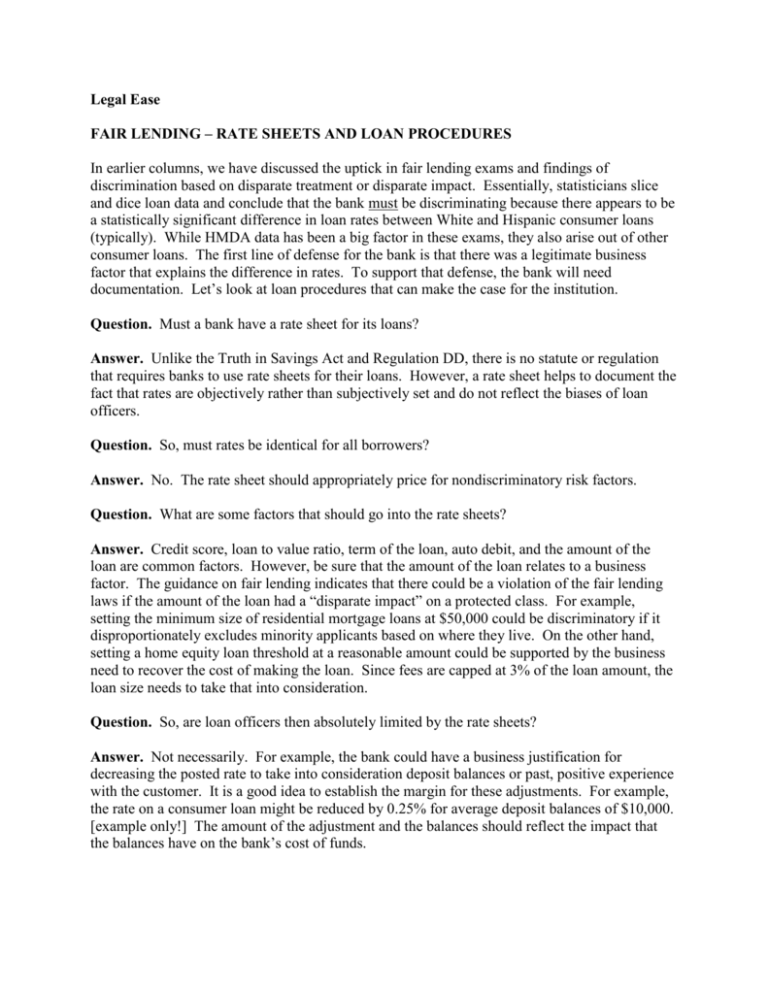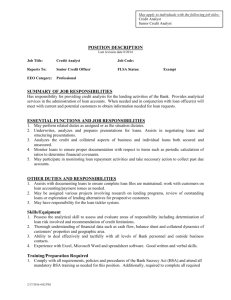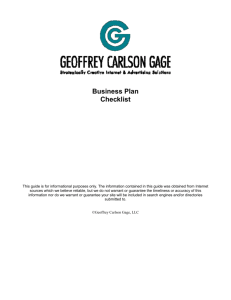Legal Ease FAIR LENDING – RATE SHEETS AND LOAN
advertisement

Legal Ease FAIR LENDING – RATE SHEETS AND LOAN PROCEDURES In earlier columns, we have discussed the uptick in fair lending exams and findings of discrimination based on disparate treatment or disparate impact. Essentially, statisticians slice and dice loan data and conclude that the bank must be discriminating because there appears to be a statistically significant difference in loan rates between White and Hispanic consumer loans (typically). While HMDA data has been a big factor in these exams, they also arise out of other consumer loans. The first line of defense for the bank is that there was a legitimate business factor that explains the difference in rates. To support that defense, the bank will need documentation. Let’s look at loan procedures that can make the case for the institution. Question. Must a bank have a rate sheet for its loans? Answer. Unlike the Truth in Savings Act and Regulation DD, there is no statute or regulation that requires banks to use rate sheets for their loans. However, a rate sheet helps to document the fact that rates are objectively rather than subjectively set and do not reflect the biases of loan officers. Question. So, must rates be identical for all borrowers? Answer. No. The rate sheet should appropriately price for nondiscriminatory risk factors. Question. What are some factors that should go into the rate sheets? Answer. Credit score, loan to value ratio, term of the loan, auto debit, and the amount of the loan are common factors. However, be sure that the amount of the loan relates to a business factor. The guidance on fair lending indicates that there could be a violation of the fair lending laws if the amount of the loan had a “disparate impact” on a protected class. For example, setting the minimum size of residential mortgage loans at $50,000 could be discriminatory if it disproportionately excludes minority applicants based on where they live. On the other hand, setting a home equity loan threshold at a reasonable amount could be supported by the business need to recover the cost of making the loan. Since fees are capped at 3% of the loan amount, the loan size needs to take that into consideration. Question. So, are loan officers then absolutely limited by the rate sheets? Answer. Not necessarily. For example, the bank could have a business justification for decreasing the posted rate to take into consideration deposit balances or past, positive experience with the customer. It is a good idea to establish the margin for these adjustments. For example, the rate on a consumer loan might be reduced by 0.25% for average deposit balances of $10,000. [example only!] The amount of the adjustment and the balances should reflect the impact that the balances have on the bank’s cost of funds. Similarly, the loan officer might want to reduce the posted rate based on past loan experience with the customer or because of other, familial relationships with the bank. In that event, the officer who is deviating from the rate sheet should write down the reason for the adjustment on the loan memo and get approval for the change. The bank’s loan procedures should spell out who should approve such transactions as well as the size of the variances that are acceptable. It is critical that there be objective standards. Question. Although our bank is not large, we have branches in several different communities. Do our rate sheets have to be identical in each market? Answer. No. You can take competitive factors into consideration. However, be sure to document! You might keep copies of ads from competitors or use secret shoppers. Again, the key is that the rate relates to a business justification. If your rates are higher in minority markets, be sure that you can objectively demonstrate that the rates in the nonminority markets are the result of competitive pressure and real risk factors. Otherwise, you face the argument that market is just a proxy for a prohibited factor. Question. Are there other issues that we should keep in mind for our loan procedures? Answer. Yes. Review your incentive compensation program to make sure that you are not creating an incentive for loan officers to put applicants into a more expensive loan in order to maximize their own bonus. Avoid the appearance of “steering” applicants into a higher cost credit product. This column has focused on pricing. However, don’t forget the importance of good procedures in making the credit decision. Consider a “second look” review for applicants who are in a protected class. We have discussed fair lending in the context of consumer transactions. Don’t forget that the Equal Credit Opportunity Act also applies to business credit. Pricing business loans is a lot more complex than pricing consumer ones. However, for your very small business loans, a rate sheet may still be a good tactic to avoid the appearance of discrimination. Question. What are the consequences of a bad fair lending exam? Answer. The bank’s CRA rating will be downgraded. This will affect the bank’s ability to bid on state public funds (and some local government funds). The matter will be referred to Department of Justice if there is a “pattern or practice” of discrimination uncovered. The FDIC will not approve new branch applications. The bank may be required to cure the violation by reducing the rates on certain loans and refunding excess interest. In short, fair lending violations can be very costly…in time, money and reputation.







